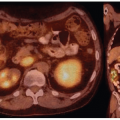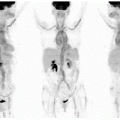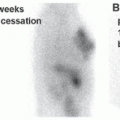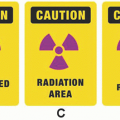Basics of Radiochemistry
Kai Chen
LEARNING OBJECTIVES
1. Describe the composition and behavior of atomic nucleus.
2. Describe different types of radiation.
3. List possible methods for producing radionuclides.
4. Describe different approaches for radiolabeling with positron emission tomography (PET) radionuclides.
5. Identify the difference between radiochemicals and radiopharmaceuticals.
6. List commonly used tests for quality control of radiopharmaceuticals.
INTRODUCTION
In this chapter, the basic concepts of radionuclide and radiochemistry are discussed, including the nuclear forces acting in the nucleus of the atoms, the kinds and source of nuclear radiations, the interactions of radionuclide with matter, the applications of radiochemistry approaches for radiolabeling of positron emission tomography (PET) tracers, and the development of radiopharmaceuticals. The fundamental role of radiochemistry in nuclear radiology is to synthesize radiopharmaceuticals for diagnostic and therapeutic applications in clinic.
BASIC CONCEPTS OF RADIONUCLIDE
Atomic nucleus
The atomic nucleus was discovered by Ernest Rutherford, an English physicist, on the basis of the Geiger-Marsden experiments (1). In their experiments, Marsden and Hans Geiger studied the backscattering of positively charged alpha rays from a gold plate and observed that very small portions (about 1 in 100,000) of these particles were scattered back at an angle of 180°. Because the backscattering of the alpha particles is directed by electrostatic forces, this is possible only if a very high portion of the positive charge of the atom is concentrated in very small volume. This part of the atom is the atomic nucleus. The backscattered portion of the alpha particles indicates that the radius of the nucleus is about 105 times smaller than the radius of the atom. In addition to the positive charge, the mass of the atom is concentrated in the nucleus. The density of any atomic nucleus is approximately the same, independent of the identity of the atoms. The mass of the nucleus is evenly distributed in the nucleus. The alpha-backscattering experiments proved that the atomic nucleus have mass, charge, and well-defined geometric size. According to the alpha-backscattering experiments, J.J. Thomson’s atomic model was conceptualized where electrons must be present in the nucleus in order to neutralize the positive charge of the protons (2). Later on, it was proved that electrons cannot be present in the nucleus due to their high energy. Electrons would leave the nucleus instantly if they were restricted in the nucleus. Subsequently, in 1920, Rutherford conceptualized that the nucleus contains neutral particles that explain the difference between the charge and the mass of the nucleus. These particles, as called “neutrons,” were experimentally demonstrated by James Chadwick in 1932 (3). Atomic nucleus consists of protons and neutrons. The number of protons is the atomic number (Z), and the sum of the number of protons (Z) and neutrons (N) is the mass number (A). The particles composing the nuclei are called “nucleons.” The nuclei are classified as isotope, isobar, isotone, or isodiaphere based on the number of nucleons (Table 2.1).
Table 2.1 CLASSIFICATION OF NUCLEI ON THE BASIS OF THE NUMBER OF NUCLEONS | ||||||||||||||||||||||
|---|---|---|---|---|---|---|---|---|---|---|---|---|---|---|---|---|---|---|---|---|---|---|
|
Forces in the nucleus
The masses of free protons, neutrons, and electrons are listed in Table 2.2. The sum of the mass of the free nucleons is always greater than the mass of the corresponding nucleus in the atom. This difference will be equal to the binding energy of the nucleus (ΔE). The stability of a given nucleus can be characterized by the ΔE value per nucleon. The characteristic ΔE per nucleon for the most stable nuclei is in the range of 7 to 9 MeV. The binding energy is often expressed in millions of electron volts. One electron volt is the amount of energy gained by an electron when it is accelerated through an electric potential of 1 V. The energy of an atomic mass unit (931 MeV) is about 1013 J (joule, the SI unit of energy). The binding energy per nucleon (7-9 MeV) is about 108 kJ, and the binding energy of the nuclei is about 108 kJ/mol. The energy of primary ionic and covalent bonds is a few hundred kJ/mol (an amount of electron volts). Therefore, the binding energy of the nuclei is about a million times higher than the energy of the chemical bonds.
Table 2.2 THE MASSES OF THE ATOMIC PARTICLES | ||||||||||||||||
|---|---|---|---|---|---|---|---|---|---|---|---|---|---|---|---|---|
|
An interpretation of the nature of the forces in the atomic nuclei was provided by Yukawa using quantum mechanics in 1935 (4). Yukawa constructed a model similar to the one for electrostatic forces, where two charged particles interact through the electromagnetic field. The total nuclear ΔE can be approximately calculated on the basis of nuclear forces, by the summation of the interaction energies of the nucleon pairs at a certain distance. In general, nuclei with the equal number of protons and neutrons should be stable. For heavier nuclei, with the increase of the electrostatic repulsion of the positively charged protons, extra neutrons are needed for stability.
Isotopes and radioactive decay
The term “isotope” was coined by a Scottish doctor and writer Margaret Todd in 1913 in a suggestion to chemist Frederick Soddy, who postulated that elements consist of atoms with the same number of protons but different numbers of neutrons (5). If the ratio of the neutrons and protons is not optimal as the stable state of an atom, the nucleus decomposes and emits radiation. This process is known as “radioactive decay.” The rest mass of the parent nucleus is greater than the total rest mass of the daughter nucleus and the emitted particle(s). The difference in the masses can be accounted for as the energy of the emitted radiation or particles. The emitted energy is usually not released in the form of thermal energy but rather as the energy of the radiation and high-energy particles.
Absolution activity (A) is defined as the number of decompositions in a unit time. Radioactivity is in proportion to the initial quantity of the radioactive nuclei:
A = A0 e–λt
The unit of radioactivity is the becquerel (Bq), which describes the number of decomposition/disintegrations that take place in 1 s (1 Bq = dps = disintegrations per second). An earlier unit of radioactivity was the curie (Ci), which is the number of decompositions in 1 g of radium in 1 s. The relation between the two activity units is 1 Ci = 3.7 × 1010 Bq. For a significant number of identical atoms, the overall decay rate can be expressed as a decay constant or half-life.
The mechanism of radioactive decay can be generally categorized into the following groups: (i) alpha decay, (ii) beta decay, (iii) gamma decay, (iv) neutron emission, (v) electron capture, (vi) spontaneous fission, and (vii) exotic decay. Alpha decay occurs when the nucleus ejects an alpha particle. Alpha particles consist of two protons and two neutrons. The energy of alpha radiation is in the range of 4 to 10 MeV. Beta decay occurs in two ways: (i) beta-plus decay, when the nucleus emits a positron and a neutrino in a process that changes a proton to a neutron, or (ii) beta-minus decay, when the nucleus emits an electron and an antineutrino in a process that changes a neutron to a proton. In gamma decay, a radioactive nucleus first decays by the emission of an alpha or beta particle. The resulting daughter nucleus is usually left in an excited state and it can decay to a lower-energy state by emitting a gamma ray photon.
Interaction of radiation with matter
Radiation can partially or completely transfer its energy to matter. It can also be absorbed, scattered elastically, or inelastically. As a consequence, the matter undergoes excitation or ionization. Nuclear resonance or nuclear reactions can be induced. The interactions between radiation and matter can be weak or strong. The interaction possibilities are summarized in Figure 2.1.
The interaction of ionizing radiation with matter is the foundation for radiation detection and measurement. Radiation is either particulate or electromagnetic. Particulate radiation includes charged particles, such as alpha particles, beta particles, and neutral particles. Electromagnetic radiation includes X-rays and gamma rays, which are high-energy photons that interact with matter in the same manner as particles. The most important types of ionizing radiation in nuclear medicine are alpha particles, beta particles, X-rays, and gamma rays.
Alpha particles can interact with orbital electrons, leading to ionization or other chemical changes. They can be scattered with the nuclear field or initiate nuclear reactions with the nucleus. When beta particle interacts with matter, the electrons in the matter may be excited or ionized, and the direction of the pathway of the beta particle may change as a result of elastic and inelastic collisions. A summary of interaction of beta particles with matter is shown in Figure 2.2. Because gamma radiation has no mass or charge, it is very different from alpha and beta radiation. The major type of the interaction of gamma radiation with matter is strongly affected by the energy of gamma photons. Depending
on the energy, the gamma photons can interact with the orbital electrons, the nuclear field, and the nucleus.
on the energy, the gamma photons can interact with the orbital electrons, the nuclear field, and the nucleus.
Production of radionuclides
Radionuclides used in nuclear medicine are usually produced by either a nuclear reactor or an accelerator. Some radionuclides are available from radionuclide generators to supply the desired radionuclide when it is needed. The production of medically useful radionuclides involves a nuclear reaction between stable target nuclei and bombarding high-energy particles.
A nuclear reactor contains fuel rods of enriched fissionable 235U positioned in the reactor core. The fuel rods are surrounded by a moderator such as heavy water (D2O). When the uranium atoms fission, they release more neutrons, which sustain the chain reaction. The fission process generates heat that is carried off by water or other coolants through heat exchangers. Nuclear reactors are designed with different purposes. Isotope production reactors have specialized ports where target material may be introduced into the neutron flux, causing neutron activation of stable nuclides into radionuclides.
A cyclotron is a type of particle accelerator, which accelerates charged particles outward from the center along a spiral path (6). The basic construction of a cyclotron consists of two hollow, semicircular chambers called Dees placed in a magnetic field. The Dees are coupled to a high-frequency electrical system that alternates the electrical potential on each Dee during cyclotron operation. When the proton is accelerated into the opposite Dee, the radius of the proton circular path will increase as a result of its increased kinetic energy. This process is repeated until the proton acquires great energy. Then the proton is deflected onto a target where the desired nuclear reaction takes place. Cyclotrons for producing medically useful radionuclides usually operate between 11 MeV and 17 MeV.
A generator consists of a long-lived parent nuclide that decays to a short-lived daughter. The daughter nuclide can be chemically separated from the parent nuclide. Radionuclide generators are a convenient means of supplying good amounts of short-lived radionuclides for use in the hospital. For example, a 68Ge/68Ga generator is used to extract the positron-emitting isotope 68Ga from a source of decaying 68Ge with a 271-day half-life. After its production in a cyclotron by the proton bombardment of stable gallium, 68Ge is adsorbed on various columns containing alumina, titanium oxide, or stannic oxide. Then, the accumulated 68Ga activity in the generator can be eluted with 0.1 M to 1.0 M hydrochloric acid as gallium chloride.
BASIC CONCEPTS OF RADIOLABELING
Isotopic labeling
Isotopic labeling involves the substitution of a stable atom in a compound with its radioisotope, producing a radioactive analogue. The radioactive analogue has similar chemical and biologic properties to the parent compound, and thus it is a true physiologic tracer. A good example of this in nuclear medicine is radioactive iodide (131I- or 123I-) as a radioactive analogue of stable iodide 127I. Although isotopic labeling is a good approach to the preparation of radioactive analogues, it has practical limitations. Biologic molecules of interest are composed mostly of the elements carbon, hydrogen, oxygen, nitrogen, phosphorus, and sulfur. Their radioisotopes generally have undesirable radioactive properties for clinical use, such as unsatisfactory half-life and photon energy.
Nonisotopic labeling
Nonisotopic labeling involves incorporating a radioactive atom that is not native to the compound being labeled. Nonisotopic labeling is not ideal because the presence of a nonisotopic atom in a molecule may change its biochemical properties. If the radionuclide is located at a site involved with biological target binding, the biological properties of the radiolabeled molecule can be altered.
Specific activity
Specific activity is the ratio of the radioactivity to the mass of a radionuclide or a radioactive compound. Typical units might be
curies per millimole (Ci/mmol) or microcuries per microgram (µCi/µg). The mass of a radionuclide in a given amount of activity can be determined from the number of radioactive atoms present. For small capacity and high affinity receptor binding, a high specific activity of radioligands is demanded, whereas a low specific activity of radiotracers may be acceptable for large capacity and low affinity biological systems.
curies per millimole (Ci/mmol) or microcuries per microgram (µCi/µg). The mass of a radionuclide in a given amount of activity can be determined from the number of radioactive atoms present. For small capacity and high affinity receptor binding, a high specific activity of radioligands is demanded, whereas a low specific activity of radiotracers may be acceptable for large capacity and low affinity biological systems.
Radiochemistry for positron emission tomography tracers
PET is a noninvasive functional imaging technique with good resolution and high sensitivity. In PET, the radionuclide decays and the resulting positrons subsequently interact with nearby electrons after travelling a short distance (˜1 mm) within the body. Each positron-electron transmutation produces two 511-KeV gamma photons in opposite trajectories, and these two gamma photons may be detected by the detectors surrounding the subject to precisely locate the source of the decay event. Subsequently, the “coincidence events” data can be processed by computers to reconstruct the spatial distribution of the radiotracers (7).
PET imaging can provide quantitative information of physiological, biochemical, and pharmacological processes in living subjects. It is possible to synthesize PET probes with the same chemical structure as the parent unlabeled molecules without altering their biological activity. PET has been widely applied not only in the field of oncology, cardiology, and neurology (8,9,10), but also in the process of drug development (11,12). The potential of PET in clinical setting heavily relies on the availability of suitable PET tracers, and radiochemistry is a challenging factor for clinical applications of PET.
Radionuclide selection
Several positron-emitting radionuclides can be used in the development of a PET radiotracer. These radionuclides include, but are not limited to, 18F (Emax 635 KeV, t1/2 109.8 min), 11C (Emax 970 KeV, t1/2 20.4 min), 15O (Emax 1.73 MeV, t1/2 2.04 min), 13N (Emax 1.30 MeV, t1/2 9.97 min), 64Cu (Emax 657 KeV, t1/2 12.7 h), 68Ga (Emax 1.90 MeV, t1/2 68.1 min), and 124I (Emax 2.13 MeV; 1.53 MeV; 808 KeV, t1/2 4.2 days). The selection of the PET radionuclide is depended on its physical and chemical characteristics, availability, and the studied time course of biological process (7,13). The half-life of the PET radionuclide determines whether the radiolabeling procedure of incorporating the radionuclide into the target compound is appropriate and/or feasible. For instance, if a relatively lengthy radiolabeling procedure is required, or the tracers need to be transported from the radiolabeling sites to imaging sites, it may not be possible to use shortlived isotopes such as 11C. Due to the very short half-lives of 15O and 13N, the tracers containing 15O or 13N are usually prepared in the chemical forms directly from a cyclotron target, or their derivatives that can be obtained by reactions in a very high radiochemical yield. Other factors for the radionuclide selection include the radiolabeling conditions, tracer specific activity, and radionuclide production. In addition, the physical half-life of the PET radionuclide should match the biological half-life of the corresponding tracer in order to achieve good target-to-background ratio, that is, high contrast images. For small molecules and peptides exhibiting fast clearance, 18F with a short half-life may be a better choice. For antibodies who have the binding equilibrium of several hours or days in the body after intravenous injection of the tracer, radionuclides such as 64Cu or 89Zr with relatively longer half-lives may be optimal.
Radiochemistry with positron emission tomography radionuclides
Radiolabeling is a chemical process during which a radionuclide is incorporated into a desired molecule. For PET radiochemistry, radiation safety and radiolabeling effectiveness are essential when dealing with high-energy short-lived radioactive compounds. Traditional bench-top organic synthesis approaches may not be applicable for radiochemistry. In order to reduce radiation exposure to radiochemists, radiolabeling is often performed in radiosynthesis modules located in lead-shielded hot cells. In addition, the development of rapid radiosynthetic methods for introducing short-lived positron-emitting isotopes into the molecule of interest is also a challenge for radiochemists. PET tracers must be radio synthesized, purified, formulated, and analyzed within a few half-lives of the radionuclide to ensure that enough radiation doses can be administered into a subject undergoing PET scans. The radiochemical approaches are very limited for PET probes based on the extremely short-lived radionuclides, such as 15O and 13N. Radiolabeling with 18F and 11C is usually carried out using organic chemistry approaches. Although a single-step reaction with a high yield is preferred, it is necessary in some cases to protect reactive groups of the target molecule or perform the radiolabeling using prosthetic agents. For radiometals, such as 64Cu, 89Zr, and 68Ga, the radiolabeling reaction is often performed using coordination chemistry. Biomolecules are commonly modified with a suitable metal-chelating group prior to the chelation of the radiometal. Recently, a wide range of new technologies, including solid-phase extraction (SPE) and microfluidics, have been adapted into radiolabeling procedure to further speed up radiolabeling, enhance radiolabeling efficiency, and facilitate product purification.
Radiolabeling with F-18
Fluorine-18 appears to be an ideal radionuclide for routine PET imaging because of its almost perfect chemical and nuclear properties (7). Compared with other short-lived radionuclides, such as 11C, 18F has a half-life of 109.8 min, which is long enough to allow for time-consuming multistep radiosynthesis as well as imaging procedures to be extended over several hours. In addition, the low β+-energy of 18F, 635 KeV, promises a short positron linear range in tissue, contributing to high spatial resolution PET images. There are varieties of chemical methods to incorporate the 18F isotope into target molecules. The synthetic strategies generally fall into two categories: (i) direct fluorination, including nucleophilic and electrophilic reactions: the 18F isotope is directly incorporated into the target molecule of interest (Fig. 2.3); and (ii) indirect fluorination: the 18F isotope is introduced using 18F-containing prosthetic agents where a multistep synthetic approach is usually involved in radiolabeling (Fig. 2.4).
Stay updated, free articles. Join our Telegram channel

Full access? Get Clinical Tree










